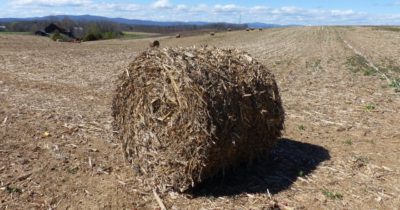In addition to the technologies for harvesting corn residues in bales described in the previous article, this biomass can be also:
- pressed into rolls using a roll baler instead of a baler of rectangular bales;
- collected in a crushed form as a mixture of different fractions of plant residues;
- collected in a crushed form in a separate fraction of plant residues, such as rods.
Сorn residues collected in rolls
Roll balers are:
 applied to smaller volumes of corn;
applied to smaller volumes of corn;- cheaper and require a lower power tractor;
- characterized by lower bandwidth than the balers of large rectangular bales;
- provide a lower compaction density and require a mesh that is more expensive than twine.
The logistics of biomass in rolls are more complex and less efficient than rectangular bales, given the reduced use of transport volume and warehouses. Therefore, it is important to carefully analyze the costs when choosing a biomass bale.
Сorn residues collected in a crushed form
Also, the windrowed corn stover can be harvested in shredded form by using a forage harvester or a forage loader wagon, which are used for silage corn harvesting (Fig. 1). Due to results of field experiments in the Bavarian State Research Centre for Agriculture in the years 2014 and 2015 the ash content of corn stover was 7.0 % in DM ±1.9 for forage harvester and 6.9% in DM ± 2.0 for forage loader wagon[1].

a) Forage harvester system: combine +tractor with stalk- shredding windrower + forage harvester + tractor with trailer

b) Forage loader wagon system: combine + tractor with stalk-shredding windrower + tractor with forage loader wagon
Fig. 1. Shredded corn stover supply chain
Another option for corn residue harvesting is to collect part of residues after threshing grain in a combine harvester. For example, researchers at Italian CREA-IT (Consiglio per la Ricerca in Agricoltura e l’Analisi dell’Economia Agraria) have carried out on-field trials to assess the performance of an innovative mechanized system to collect Maize cob in 2018[2] (fig. 2.7a). Using the combine harvester with the Harcob system, it was possible to harvest 2 t/ha in the average of cob, with a material capacity of 4.1 t/hour[3]. The Vermeer Company releases cob harvester machine CCX770 (fig. 2.7b), which is available on the market[4]. The Vermeer CCX770 cob harvester is a pull-type cob collection wagon attached to a combine harvester. This machinery enables farmers to harvest both corn and cobs – separately and simultaneously – in one pass.

Fig. 2 Cob harvesters: a – Harcob system; b – Vermeer CCX770.
Author: Semen Drahniev
[1] Monika Fleschhut, Kurt-Jurgen Hulsbergen, Stefan Thurner, Joachim Eder Analysis of different corn stover harvest systems / LANDTECHNIK, 71 (6), 2016. – 252-270 p.
[2] https://www.becoolproject.eu/2018/10/22/recovering-maize-cob-converting-untapped-biomass-resource-into-valuable-feedstock/
[3] http://www.etaflorence.it/proceedings/?detail=15215
[4] https://www.vermeer.com/NA/en/N/equipment/cob_harvester
Read also:
State of the art of corn production in the world and in Ukraine
Сorn residues and harvesting in Ukraine
Potential of corn residues in Ukraine in 2018
Fuel characteristics and properties of corn residues
Technologies for harvesting corn and corn residues